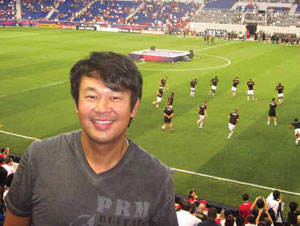Visual Impact

Minsoo Park Combines Art with Technology to Create a Picture-Perfect User Experience
Quick Bio

NAME: Minsoo Park
TITLE: President
COMPANY: PureLink
OVERTIME: Park expanded upon his skills in product development and marketing with training in aesthetics and engineering via a Master’s program in interactive telecommunicaitons at New York University’s Tisch School for the Arts.
SCN: At what point did you realize that you were destined for a career in technology?
Minsoo Park: Throughout my career, I’ve had the chance to experience and learn from the challenges, feats, and technicalities faced in all levels of a thriving industry. I first formed a growing interest in electronics during my years at Samsung as a product development specialist. I found a great attraction to the hands-on work and creativity involved in the conception of a cutting-edge product that caters to the growing needs of consumers.
Perhaps the most crucial thing I took away from my time as director of online product development at Bertelsmann was that digital connectivity was overlooked in many areas. Having honed my skill set as a designer, and with my background in business management, I became passionate about creating an environment that could implement and combine each aspect to fully maximize usability and adaptability for the consumer.

Minsoo Park at the Manchester United vs. MLS All-Stars game at Red Bull Arena in Harrison, NJ.
A daily selection of the top stories for AV integrators, resellers and consultants. Sign up below.
By the end of my coursework at NYU , I had made observations through the eyes of a businessman, designer, innovator, and engineer. Bringing all these aspects together is not only what established the PureLink brand, but is what makes PureLink a leading competitor in the AV industry today.
SCN: After earning your undergraduate degree in business management, you worked for four years at Samsung in Korea. What was the most significant idea you took away from that experience?
MP: Three things have always stayed with me since then. The first is that in order to stay ahead of the pack, you must have a keen eye for keeping up with trends. Innovative thinking not only requires keeping pace, but constant re-evaluation and forecasting what consumers want and need next. Once an idea is generated, it is important to work as a team to execute and develop new products. The team must value each member’s input, and implement new strategies to create a product that not only meets but surpasses users’ needs.
Lastly, there is no final product. Technology is always evolving. It is important to know that while we are striving to create the “latest and the greatest,” there is always room for improvement.
SCN: Later you earned your Master’s in interactive telecommunications at New York University’s Tisch School of the Arts. The latter program is described as “The Center for the Recently Possible.” How did your graduate studies influence your viewpoint on technology?
MP: This program is what gave me the “finishing touch,” so to speak, that I needed to become an entrepreneur in this field. Given my background in business, my strengths lay in product development and marketing, yet I still wanted to solidify my skills in aesthetics and engineering. I learned the effects of visual art on technology, and how the two can merge. It was the fusion of all these that led to the birth of PureLink—where user friendly interfaces and core technology come together.
SCN: What do you learn about customer needs from the “Ask Minsoo” section of the PureLink website?
MP: From our inception, my priorities have been to offer leading edge connectivity solutions, robust quality, and the highest level of customer satisfaction possible. The “Ask Minsoo” section allows me to connect personally with our end-users and discern their needs, which then allows us to innovate more responsively. We’ve also tackled more challenging questions raised by engineers, which gives us the feedback we need to continually evolve and improve our line even further. We are always striving to provide our customers with the best solutions, and an application design that is implemented and successfully executed gives us all a powerful sense of accomplishment.
SCN: Looking ahead, what is the greatest technological challenge faced by the AV industry?
MP: The biggest challenges we face are the ever-changing standards in technology. PureLink is now in its twelfth year as a manufacturer of digital connectivity products, and our main drive has been forecasting trends. Thorough testing and evaluation of new technologies to make sure that they meet spec is critical for us. The analog-to-digital transition has been especially challenging for this industry, as many digital applications are still designed for analog devices. With that in mind, we have not simply created a product but a complete digital connectivity solution that offers everyone the same peace of mind they once had while using analog equipment.
Kirsten Nelson is the editor of SCN.
